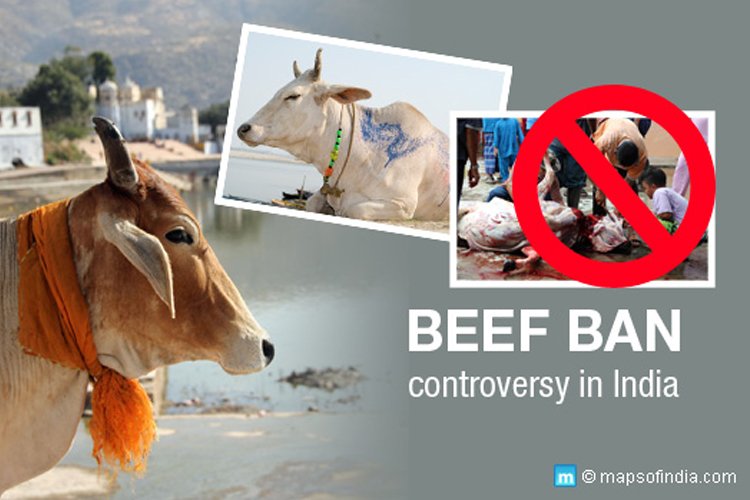
Written By�Rohit Parakh, Email: rohit.2691@gmail.com | Image Source: mapsofindiaA Logical Viewpoint On The Beef Debate
6 July 2016 10:56 AM GMT
Did you know that beef (and red meat) while provides protein has been said to be ‘probably carcinogenic’ by World Health Organization (WHO).
Over the last year or so, we have read/heard a very polarizing debate on beef ban which has primarily been based on religion. At the risk of generalization, a big part of mainstream media and politicians as with a lot of topics recently on the whole, has unfortunately taken a binary view of the debate. The debate has sadly not been focused on economic, environmental, health parameters and animal rights. Below is an attempt to portray a rational, logical and non-binary view of the debate.
Health & Nutrition
The International Agency for Research on Cancer (IARC), which is WHO’s specialized cancer agency in October 2015 came up with the conclusion that red meat (including beef, pork, lamb, mutton, goat, etc) is ‘probably carcinogenic’ (meaning probably causing cancer) and processed meat (hotdog, sausage, ham, etc) is carcinogenic (cancer causing). This came as an outcome of 800 combined studies done on red and processed meat.
While it does not ask people to quit red/processed meat, it does ask people to limit intake of red and processed meat as they are also linked to increased deaths from heart diseases, diabetes, and other illnesses. More details can be read here.
On the other hand, India has a population which according to multiple surveys has a high proportion (especially the poor) not getting adequate protein supplies. While we close the gap and ensure protein sufficiency for the population by non-carcinogenic sources, it would be cruel to ban the population from getting protein they can get through red/processed meat.
Economic
The banning of beef has had a negative impact on many livelihoods dependent on it. This has caused scarcity of raw material, which is leading to a decline in many industries such as leather, chemicals and export industries including the famous kolhapuri chappal. In a period, where demand for new jobs is far exceeding their supply, it is critical that well-thought of alternate livelihood strategies are planned and executed by the government for the ones who are being/have been affected.
Environmental
Not many might know, but a decade ago in 2006 the UN FAO (Food and Agriculture Organization) came up with a study that 18% of total emissions are caused by livestock (including beef production and consumption) industry. This 18% figure is higher than greenhouse gas discharge from cars and planes combined! A few years later, in a World Watch Institute report two World Bank environmental advisors claimed this figure to be at 51%. While there is still debate between 18% and 51% numbers, what is increasingly clear that the livestock industry is a large producer of greenhouse gas emissions (caused by factors including trees/forests cut to grow pastures for livestock, high water footprint and overall lifecycle) hasn’t received press or mention in policy actions anywhere as close to other emitters. We all need to take a look at our actions and see if/how they contribute directly/indirectly to global warming.
Animal Cruelty
As an article in The Hindu mentions, dairy industry involves a lot of suffering for dairy animals. “Soon after birth, calves are separated from cows to ensure greater milk for humans and calves are allowed limited suckling and milk substitutes. A lot of male calves are sent for slaughter, let loose to starve (or eat garbage), sent to castration without anesthesia, nose-roping, whipping and hard labour until they are old and weak. At which point they are then sent for slaughter or abandoned. This is evident in gender imbalance 64.4% female and 35.6% male in cattle, and 85.2% female and 14.8% male in buffalo.” Even the artificial insemination, which National Dairy Plan aims to have for 35% of dairy animals by 2017 requires extracting semen from bulls and forcibly placing it in restrained cows. Milk production often uses banned oxytocin (a hormone) which although gets cows to produce more milk, causes not only harm to cows but also humans drinking its milk.
Once they stop yielding milk, they are either sent to slaughterhouses or let loose on their own. The question we all need to ask ourselves, is whether in 2016 this is justifiable for the dairy animals.
Do such top-down bans work for a long time?
The common ‘what about’ arguments based on cigarettes (and other known harmful materials) not being banned should not be valid. If banning cigarettes were the right solution to tackle it, then it being banned should not be the prerequisite for banning beef. Whilst Kerala and Bihar learn their own lessons from banning alcohol consumption, it might be worth taking a stock from lessons of Hiware Bazar’s and Gujarat’s experiments on banning alcohol. Gujarat which has officially been a dry state for more than 50 years, has had rampant alcohol availability through a well-organized nexus. Hiware Bazar (a small village in neighboring Maharashtra) has had unprecedented success in banning alcohol because of the support/demand for alcohol ban from grassroots and high awareness on the negative impacts of alcohol.
While banning and its implementation in a village are quite different from doing it on a large scale in a state, it does have enough lessons for bans. The key act is not the ban itself, rather awareness and grassroots support leads to success/failure of a policy. Ban – if any must be the last step after the above-mentioned actions and must be continuously evaluated.
Public Response to Ban
The need of the hour is nuanced debates, where discussions are not binary nor with a self-righteous view to prove the other side wrong. Rather they must be done with a focus on facts and emphasis on the curiosity of learning. Demonizing and spreading hatred against any individual/community can never lead to positive results.
 All section
All section













